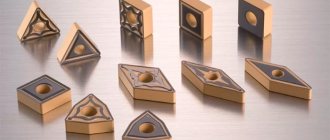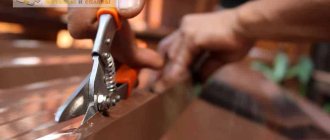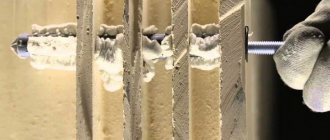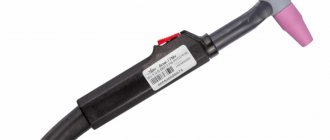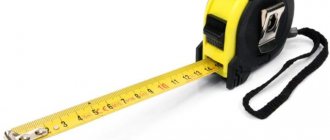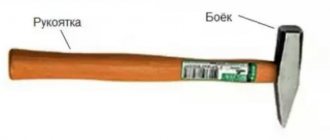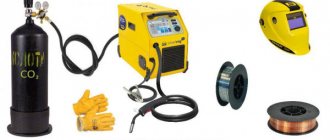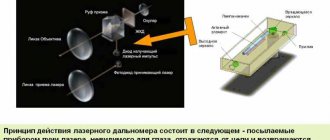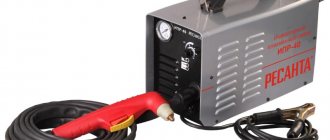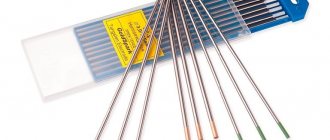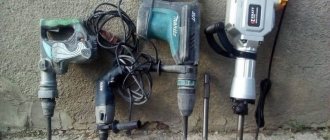Purpose and scope of application of angle grinders
The term “grinder” to designate this construction tool appeared in the Soviet Union in the early 70s of the last century. Angle grinders received this name due to their place of origin; their production was established in Plovdiv.
The angle grinder was designed by Ackermann + Schmitt (FLEX-Elektrowerkzeuge GmbH) in Steinheim an der Mur in 1954. The angle grinder quickly gained popularity among specialists; one of the main factors for the success of the tool was its versatility.
The use of special equipment allows angle grinders to perform cutting and grinding operations on a wide range of different materials:
Ferrous and non-ferrous metals, as well as their alloys.
Natural and artificial stone.
Ceramic and silicate bricks.
Concrete and products made from it.
All types of facing ceramic tiles.
Sanding wood.
It is not recommended to use a grinder for cutting glass and wood; due to the high linear speed, heating occurs at the point of contact of the equipment and ignition is possible. In recent years, circular saws have been produced for working on wood with tips made from special refractory alloys. This equipment should be used very carefully and should not be allowed to overheat. The above list of materials determines the main areas of application of angle grinders.
This power tool is widely used:
- In construction.
- At enterprises related to metalworking.
- In car service workshops for body work.
The population has a lot of angle grinders in their hands; household owners actively use them to perform household work. With its help, cutting and grinding of the above materials is carried out. This power tool, in particular, processes welding seams and removes scale. The operation does not take much time and allows you to avoid unnecessary impact loads on the fresh joint.
What is a grinder used for and what main parts does it consist of?
This instrument received the nickname “grinder” back in Soviet times at the beginning of 1970. Angle grinders received this name because of their country of origin; production was launched at the Eltos plant in Bulgaria. The angle grinder was designed by Ackermann + Schmitt (FLEX-Elektrowerkzeuge GmbH) in Steinheim an der Mur in 1954. The angle grinder quickly became popular among professionals because the tool became universal.
The use of special equipment allows angle grinders to perform cutting and grinding operations on a wide range of different materials:
Ferrous and non-ferrous metals, as well as their alloys
Natural and artificial stone
Ceramic and silicate bricks
Concrete and products made from it
All types of ceramic tiles
Sanding wood
It is not recommended to use a grinder for cutting glass and wood; due to the high linear speed at the point of contact of the equipment, overheating + possible ignition occurs. Now special circular saws are produced for working on wood with tips made from special refractory alloys. This equipment must be used with caution to avoid overheating. The above list of materials defines the main types of work for the use of angle grinders.
This power tool is widely used:
- In construction.
- At enterprises related to metalworking.
- In car service workshops for body work.
Household owners actively use angle grinders to perform household work. With its help, cutting and grinding of the above materials are carried out. This power tool, in particular, processes welding seams and removes scale. Such work does not take much time and allows you to avoid unnecessary impact loads on the weld.
Design of angle grinders, components
The design of angle grinders is characterized by a relatively simple and technologically advanced design, which made it possible to establish their production at many enterprises.
The angle grinder consists of the following parts:
The body, which is made of reinforced polymers. Such materials are characterized by high strength, resistance to wear and environmental influences. On the outer surface there is a button to turn on the tool with a lock. Some models have windows covered with hatches for replacing drive brushes.
An electric motor powered by a household network or batteries. Angler grinders use drives that can provide high shaft speeds. To cool the windings and other parts, a fan is installed on the front part of the axis.
Single-stage bevel gearbox in a separate housing made primarily of magnesium or aluminum alloys. It consists of bevel gears, the shafts of which are mounted on ball or plain bearings. The interaction of the parts with each other in the gearbox is ensured by the housing, which is filled with grease.
A spindle consisting of a shaft with a metric thread, a thick-walled washer and a nut for attaching a cutting disc or other equipment. On the gear housing there is usually a button on the opposite side that locks the shaft in place. This is necessary for dismantling and installing new equipment.
The removable handle is threaded and can be screwed into the gear housing in one of the selected positions. This is done for the convenience of holding the power tool while performing various types of work.
The protective casing covers part of the cutting disc and does not allow the sheaf of sparks that is formed during operation to fly away in all directions. The device protects the worker and surrounding objects from equipment wear products and material fragments formed during its processing.
The angle grinder is supplied to the consumer complete with a user manual and a special key for attaching the equipment. The latter is a steel strip with two pins that exactly match the holes of the fixing nut. In some cases, the manufacturer adds spare carbon brushes to the package.
Operating principle of an angle grinder
The angle grinder is driven by an electric motor, which is turned on by pressing a locking button or switch. Power is supplied from the network, as well as from a built-in or removable battery. Mostly, the tool is equipped with commutator electric motors, the stator winding of which has a high inductive resistance. This circumstance makes it possible to significantly reduce operating currents.
Spinning, the electric motor shaft rotates the drive gear in the gearbox, which drives the driven gear, and thus transmits force to the spindle. The mechanism body is made of magnesium or aluminum alloys to improve heat transfer. The gearing between gears is of two types: spur and helical (bevel Glisson system). The second option is preferable because it provides greater reliability and helps reduce noise.
More expensive and complex models use a release clutch installed between the engine and the gearbox. The main function of this unit is to prevent kickback when the disk suddenly stops due to jamming. This allows you to protect the operator from possible injury and the grinder components from damage. On such angle grinders, the spindle lock button can be pressed until it stops completely.
The choice of a design scheme in which the plane of rotation of the cutting disc or brush is parallel to the axis of the tool is explained quite simply. When an angle grinder operates, a significant torque occurs, tending to pull the tool to the side. This force is easily compensated by the operator due to the optimal positioning of the hands along and perpendicular to the axis.
Device
An angle grinder is a simple tool by modern standards. Its main parts:
- frame;
- electric drive;
- gearbox;
- spindle;
- protective casing;
- lever.
The housing is made of durable materials to protect the angle grinder from stress and accidental impacts from the external environment. The body houses buttons and controls.
The drive is powered from a 220 V network, less often from batteries. The rapid rotation creates heat, so a fan is placed nearby.
The gearbox has only one stage. Placed in a separate fenced section filled with lubricant.
The spindle has a thread through which the saw blade or grinding wheel is secured with a washer and nut.
Grinding machine device
The protective casing prevents sparks and particles of the processed material from flying towards the worker.
The handle is made removable. There are threaded holes along the body into which this handle can be screwed and thereby create a convenient option for the worker to hold the grinder.
Power, speed and tool diameter
Considering the significant difference in parameters between different models of angle grinders, the question arises, which is the best grinder to buy for home or work? It is necessary to decide: to perform, what operations it is necessary for, and what the volume of expected work is.
Rotational speed
One of the main parameters of an angle grinder is the linear speed of rotation of the wheel, which depends on the diameter of the wheel. The optimal value for this indicator is 80 m/s; a significant deviation in the speed of rotation towards an increase will lead to the destruction of the circle. A lower rotation speed causes rapid wear of the disc. There are five types of angle grinders, which vary in the size of the cutting wheels used.
The dependence of the spindle speed on the diameter of the working disk is as follows:
115 mm – 13290 rpm
125 mm – 12230 rpm
150 mm – 10190 rpm
180 mm – 8490 rpm
230 mm – 6650 rpm
Data on the permissible rotation speeds of the cutting wheel for each specific model must be indicated on a special plate that is attached to the body. The amount of torque must be sufficient to overcome the resulting friction force and maintain the required cutting speed. This characteristic is determined by the rated power of the electric motor of the angle grinder.
Angle grinder power
The rated power of angle grinders ranges from 650 to 2700 W, and depends on the diameter of the disc used. Accordingly, angle grinders designed for large diameter discs have more powerful drives. With these parameters, the electric motor provides sufficient force on the cutting edge of the wheel to effectively influence the material being processed.
For normal operation, it is necessary that the power consumption of an angle grinder with a disk diameter of 125 mm be at least 750 W. Moreover, the larger the diameter of the permissible equipment, the more powerful the engine should be. So in models with a tooling diameter of 230 mm, which are intended for intensive use on construction sites, the engine power consumption must be at least 2200 W.
Tooling diameter
Be sure to decide what diameter of the equipment will be sufficient for your needs. Remember that you cannot use circles whose diameter is larger than the permissible one. Of course, you can do this by removing the protective cover, but such manipulations are prohibited, as they can lead to injury to the operator.
It is especially dangerous to use an angle grinder without a protective casing when working with metal discs with hard-melting tips, which, if they fly apart, can cause significant harm to health, including death. If you have such a desire, just find on the Internet photos of people who were injured by neglecting safety when working with angle grinders and this desire will disappear forever.
The diameter of the equipment is deeply related to such a parameter as the depth of cut. This point is especially important if you are going to use an angle grinder to cut curb stones and other thick materials. The cutting depth of the model with a disc diameter of 125 mm is only 30 mm - 35 mm, depending on the model. This is because the dimensions of the gearbox will not allow you to completely immerse the circle in the material.
Of course, you can cut a curb stone by making cuts on both sides. But it is more difficult to make such a high-quality cut, and it will take more time. Therefore, if you have to constantly cut such materials, then you should look towards “grinders” with a maximum disc diameter of 230 mm.
Angles with a small working circle are of little use for cutting super-hard materials, and large models are inconvenient for grinding car bodies.
How to choose the optimal indicator
The grinder of what power should be used to perform the work depends on the specifics of the work itself. Processed materials with different properties, intensive work in production or gentle loads when doing household work require the selection of angle grinders with both a technically sound and economically advantageous power rating.
Which is better to buy for home, power or speed, is it important or not for home use
For home work, intensive use of an angle grinder is not required . Typically, it can be used to cut a profile, corner, reinforcement, clean rust from welded surfaces, process ceramic tiles to size, and perform other similar one-time work. Depending on the materials to be worked with, the power of the grinder varies from 0.6 kW to 2.0 kW.
Bulgarian Interskol UShM-125/1100E. Photo VseInstruments.ru
Home grinders are designed for the use of small disc diameters, so they are lightweight and easy to use in hard-to-reach places. The rotation of the discs of household angle grinders is characterized by high speeds (about 12,000 rpm), which compensates for the productivity of the work performed due to the lack of power.
A good choice for professionals
Unlike household angle grinders, professional angle grinders are designed to operate under constant, long-term load . The power of professional angle grinders (up to 4 kW) allows stable operation without overheating . Such angle grinders are equipped with large diameter disks and are used as a working tool in technological processes in industry and construction. The presence of options such as soft start, speed control and others increase safety and increase the possibilities of using professional angle grinders.
Angle grinder Bosch GWS 22-230 H. Photo 220Volt
For home or professional model
To determine which grinder to choose for the home and which for intensive work, you need to proceed from its technical indicators. All power tools, including angle grinders, are divided into household and professional, depending on the time of continuous use. Household angle grinder models are designed for occasional use of 30 - 40 minutes a day.
Professional models are designed for internal use of the tool throughout the day or work shift. Professional angle grinders have enhanced protection from dust, noise and a number of systems that are designed to ensure the comfort and safety of the operator.
If the angle grinder is intended for small household work, then you should pay attention to models with disc diameters of 115 mm, 125 mm or 150 mm. The most common model for home use is an angle grinder with a disc diameter of 125 mm. To understand how to choose an angle grinder for your home, you need to outline the range of tasks to be solved and the list of materials to be processed. Obviously, purchasing an expensive professional tool in this case is unjustified.
As for professional models, the undisputed leader here is an angle grinder with a disc diameter of 230 mm. When choosing such a model, you should pay attention to the engine diameter. The larger the engine diameter, the greater the torque the angle grinder can develop, and this is very important during grueling operation.
Therefore, if you are choosing between two approximately equal angle grinders, give preference to the one that has a larger motor diameter and only secondarily look at the power. Some manufacturers themselves indicate the torque in the tool's data sheet, but many ignore this parameter.
Types of grinders (ushm)
There are a whole range of varieties and types of grinders. Some are better suited for certain conditions, while some can do more than just cut metal, and the technical characteristics can vary greatly. There are varieties that are strictly connected to a compressed air network, and there are mobile ones - battery-powered or motorized (options such as moto are not shown - they are too exotic). For the job, you can choose a powerful saw or even a long drill. The main types and types can be identified as follows.
Mini grinder
The small (mini) grinder is a small version with a light weight. Its distinctive features are work with a circle with a diameter of up to 125 mm and the absence of a side handle.
The main purpose is operations in confined spaces and hard-to-reach places. The low weight does not tire the hand, so working with the mini machine lasts longer and is more efficient.
Due to the low power (up to 1 kW), the number of revolutions is not significant, so the design does not have a gearbox. Thanks to this same feature, the vibration is weak, so the work is more accurate. This makes it easy to polish.
The functionality of the machine is enhanced by the fact that the body itself is a handle: by setting the button to permanent operation, you can very easily grind surfaces and simultaneously hold or perform related operations. Due to its small size, it is convenient to perform gating at a considerable height.
Big grinder
The large grinder is a regular version with dimensions and power that allow you to work with a circle with a diameter of up to 230 mm and requires two-handed operation.
The most common type, equipped with a protective shield, a side handle (installation in several positions is possible) and requires removal of the working disk with a special key. The work is done in the largest circles. Therefore, depending on the manufacturer and configuration, there may be built-in speed control, and the gearbox is made of durable materials. Power is supplied from the general power supply, so when choosing, you should pay attention to the length of the cord. Regardless of power supply, cutting with water supply is possible. There are also vacuum cleaners for grinders.
Unlike the small one, it is often used as a wall chaser. High power when cutting allows you to quickly obtain a high-quality result - the grooves will be even. However, it should be borne in mind that the mass of the tool can be considerable, so it will not be easy to ditch at high altitudes. As for the diameter of the circle, with its large size, cutting the wall can stop in front of the inner corner near the floor.
When cutting rolled products with such a powerful machine, it is optimal to place the metal in a stand - on racks or in a miter box.
Wireless grinder
The wireless one is powered by a battery, so its dimensions and weight speak for themselves. Working with such a machine has maximum mobility and does not require meters of extension cord.
The working part is not fundamentally different from the usual one, but the rear part is significantly different: there are connectors for attaching and connecting the battery. The kit fits into a case.
There are also changes in the motor: power from the mains is suitable for an AC motor, and the battery motor is suitable for DC. The difference is in power; a DC motor produces less power for an angle grinder.
In this regard, the purpose of a cordless machine is the accuracy of the operation performed. It is most effective to accurately and quickly cut fairly durable materials - from granite to cast iron (even such small models are enough to cut a cast iron battery). Portability makes it best for car repairs.
Grinder straight
A straight angle grinder is different in appearance: the working body is a continuation of the body, usually there is no additional handle. The work can be done with one hand. The second hand is used to correct or hold material, or to stay in space under difficult conditions.
Its purpose is to work in hard-to-reach and miniature places and an extended list of operations. For this purpose, an extension cord or an adapter for an angle grinder is supplied in the kit or separately.
The design is convenient for polishing work. To treat the surface, you can use not only discs, but also cylindrical and conical nozzles of abrasive and petal types (to remove the height of the concrete floor in the corners), drills (this way you get a grinder-drill). Adapters are available for attachments. The end installation of the circle is convenient in its own way.
The number of revolutions per minute is up to 30,000 thousand. Usually a soft start system and overload protection are installed.
Ushm pneumatic
The operation of a pneumatic angle grinder is based on the supply of air under pressure to the working part. To do this, connect to the compressed air system - there is a special connector for this purpose.
The compressed air is started by pressing the trigger. After entering the internal cavity of the machine, the air spins the rotor, which in turn, through the gearbox, creates rotation of the working circles.
Like other options, the pneumatic angle grinder comes with a protective shield and an additional handle. Compared to others, it has a longer service life and quite high power. Such a tool can be used in a polluted environment. The housing is sealed and durable due to pressure work.
However, due to air escaping from the case, it is often impossible to work without dust. However, it is possible to install a dust removal system (as on other models). Polishing is often done to prevent too much dust. And the air suspension accelerates from the supply hose.
Brushless grinder
Like any other electrical device, an angle grinder includes such an element as brushes - removable sliding-type electrical contacts. The design of the brushes is developed, but quite unified (although each manufacturer produces their own).
As a mechanical element operating under dynamic conditions with constant friction, brushes often fail. The brushless motor is the next step in the development of electrical engineering. It requires less repair due to the absence of brushes, makes less noise and does not produce sparks. This allows us to consider this model more fireproof. A brushless angle grinder works quietly in very dusty air - it has no equal in repairs and construction. The question is how to grind a concrete floor (if it is not possible to install a dust extractor).
The price is a little more expensive than the classic model, but the advantages outweigh the cost of regularly replacing the brushes.
Additional systems to support tool operation
Angle grinders have become widespread due to their convenience, versatility and reliability. The design of the power tool includes a number of systems that are designed to ensure high performance and safety of working with the tool. The functionality of each model is determined by the manufacturer at the design stage; the list of additional options affects the cost.
That is why, next we will consider additional systems that ensure the operation of an angle grinder and determine how important their presence is for the effective and safe use of the tool.
Inrush current limiting system
When the electric motor is turned on, the load on the motor winding increases abruptly by 6-8 times, which can cause damage to it or trigger the protection. This also generates an impact torque, which is transmitted through the shaft to the gearbox and spindle. The starting current limiting system is an electronic circuit that provides a smooth increase in rotation speed.
The operating principle of this system is to gradually increase the voltage on the windings over a given time. Using an angle grinder becomes safe, and the service life of the electric motor and gearbox increases.
The absence of impact during startup improves cutting accuracy and eliminates the possibility of scoring during grinding.
System for maintaining a constant number of disk revolutions
When the cutting disc comes into contact with the surface being processed, friction occurs, which increases the load on the engine and reduces the rotation speed. The system for maintaining a constant number of disk revolutions compensates for resistance and ensures that the cutting speed is maintained. Stabilization of the spindle rotation speed is carried out through the use of a constant electronic circuit.
There are two ways to maintain speed in angle grinders operating under load: by current or by spindle speed. In the first case, a current consumption sensor is used, which records its value and, as it increases, the circuit increases the voltage on the windings.
Speed control involves the use of a tacheometric sensor that monitors the rotation of the angle grinder. When this indicator decreases, the electronic circuit increases the voltage and, as a result, ensures optimal rotation speed of the equipment. The choice of a method for maintaining a constant rotation speed occurs at the design stage and is carried out taking into account the positive and negative aspects of each method.
Not all models are equipped with such a system; we can say that its presence is desirable, but not necessary.
Restart locking system
During construction work, it is possible that a power outage occurs for a variety of reasons. The angle grinder's anti-restart system prevents the engine from starting unintentionally. When the grinder suddenly stops, the worker most often simply puts the tool aside without checking the position of the switch.
A sudden resumption of power supply in this case can result in injury to the performer or damage to valuable property. For angle grinders equipped with such a system, restarting occurs only after the starter is turned off and pressed again. In this case, the user will need to take the tool in his hands, which means his actions will be meaningful and controlled.
Having such a system is very important and necessary.
Automatic disk balancing system
When using angle grinders, especially with large-diameter equipment, discs or brushes wear unevenly. This leads to imbalance, which manifests itself in the form of vibration, which does not contribute to the accuracy of the operation. Runout negatively affects the condition of the bearings and reduces the service life of the electric motor.
The automatic disk balancing system compensates for the uneven distribution of the mass of the rotating equipment. To stabilize the tool, various technical solutions are used, mainly special bearing designs with fewer balls. This system makes the product more expensive and is usually used on professional models with large diameter discs.
If you are choosing a tool for intensive use on a construction site, then it is best to give preference to models equipped with this system.
Motor overload protection system
When using an angle grinder, the load on the electric drive is not constant and in certain periods can significantly exceed the design value. To protect the engine from overloads, grinders are equipped with special systems that forcibly stop the current supply. In this case, the tool simply stops working and to resume it you must first turn it off and then turn it on again.
There are two ways to protect angle grinders from overheating: by current or by temperature. In the first option, shutdown occurs when limit parameters are exceeded, which are recorded by the electronic module. In another design, a temperature sensor is installed on the engine, which interrupts the power circuit when the parameter goes beyond the set values.
The system ensures the longest tool life but does not in any way affect the quality and safety of the work.
Dust protection system
During the process of grinding surfaces or cutting materials using an angle grinder, a significant amount of dust is generated. It enters the housing with the air flow and causes increased wear; the most vulnerable are the bearings, brush assembly and outer surfaces of the rotor and stator. Metal particles formed during cutting can cause a short circuit between the turns of the winding.
The angle grinder protection system involves the use of the following design and technological solutions:
- Installation of meshes on ventilation openings, and on expensive professional models and filter elements.
- Armoring the stator windings and using cord bands on the rotor.
- The use of closed type bearings.
- The gearbox housing is made as sealed as possible.
- Pouring windings with epoxy resins.
Dust protection systems significantly increase the service life of angle grinders and make them safe during operation, preventing short circuits.
Kickback protection system when equipment jams
A sudden stop of the equipment leads to the generation of torque, which is aimed at turning the angle grinder. In this case, significant efforts arise, and it is impossible to hold the instrument in your hands, and this is already fraught with injuries to the upper limbs and other parts of the body.
The anti-kickback protection system when the equipment jams prevents such a situation from occurring. This is realized in two ways: mechanically or using electronics. In the first option, various types of couplings are used, which operate when there is a sharp increase in resistance to shaft rotation. The second method is based on constant monitoring of current values; if a certain value is exceeded, the power is turned off.
Various manufacturers have their own developments for implementing such protection; its presence is extremely important for professional models with a large circle diameter.
Adjusting the guard without using a key
In this regard, each manufacturer has its own ways of implementing such adjustment, but what they have in common is that changing the position of the protective casing is done quickly and without using a key. This is very convenient when performing certain types of work when you need to constantly change the position of the protective casing. As a rule, it is enough to bend the lever and move the casing to the desired angle.
When using housings that require a key to adjust, repositioning them is somewhat difficult. To make their work easier, users often resort to security violations. Do not clamp the casing completely or remove it altogether. The presence of a keyless casing adjustment system is designed not only to improve the work process but also to discourage the user from rash decisions that grossly violate safety regulations.
Speed adjustment
The spindle rotation speed is adjusted using a wheel located on the tool body. On cheap models, this adjustment may not be available at all. But as practice shows, when performing certain jobs, its presence is very important and allows for better cutting or grinding. For example, when sanding plastic and various paints and varnishes, if the equipment rotates too intensely, the surface being processed can burn.
Additional functions
- Smooth ride
When the grinder is turned on, the required rotation speed is achieved gradually, without shock loads. This feature extends the life of the instrument.
- Jam protection
To prevent short circuits and winding combustion when the spindle stops rotating for any reason, such protection is used. It turns off the power to the angle grinder and thereby prevents damage.
- Unintentional activation lock
To start the unit, you need to switch a special lever. Without this, the start button will not be enabled.
- Speed controller
It is made in the form of a lever or a wheel. Allows you to regulate the speed and keep it in a specific range. This prevents damage to the disc and the surface being treated.
- Automatic balancing of the nozzle
Prevents vibration and beating of the rotating attachment.
- Quick Release Clamp
Allows you to quickly change tools. It will be relevant for professionals who change discs and attachments several times during work.
- Case
Case for angle grinder
It is made in the form of a strong suitcase in which you can store both the tool itself and attachments, circles, etc. Everything folds out into special compartments and is well fixed. Thanks to this, nothing inside rattles or moves from corner to corner.
Handles of their types and adjustments
In their classic form, angle grinders have two handles, a main one and an additional one, which is mounted on the gearbox. But in this regard, the tool has many features that are worth considering separately.
One-handed and two-handed angle grinders
There are angle grinders with one and two handles. It should be noted right away that this does not mean that you will hold the tool with one hand when working. It’s just that in a one-handed angle grinder the second hand is located on the body. One-handed angle grinders are available with disc diameters of 115 mm and 125 mm. The main advantage of one-handed angle grinders is their short length, which allows the tool to be used in hard-to-reach places, for example during body work.
The main disadvantage is that they are more difficult to hold while working. Therefore, tools for large-diameter equipment come with only two handles. In any case, holding a tool by two handles is much more convenient and safe than holding it by one handle and the body. Before purchasing a tool, you should hold it in your hands to decide which option is preferable for you.
Attaching an additional handle
The gearbox housing has at least 2 holes for attaching an additional handle. It is optimal to have 3 holes - two on the sides and one on top. This is quite enough for the convenience of performing almost any work. Some manufacturers make more than 3 positions for attaching the handle; whether such functionality is needed is up to you to decide.
Additional handle attachment points.
Adjusting the main handle
The main handle can be rotated relative to the axis of the body. Most often there are 3 positions - neutral and 900 in both directions. This allows you to select the required coverage for better and more convenient work.
Angles of rotation of the main handle of the angle grinder.
Vibration damping handle
When using an angle grinder, vibration occurs, to dampen it a special vibration-damping handle is used. Not all models are equipped with such a handle. As a rule, these are more expensive or professional angle grinders. It may seem that this is not such an important detail, but from experience I can say that the operation of an angle grinder with an anti-vibration handle is much softer and more comfortable. Therefore, it is better if the tool is equipped with such a handle.
Makita GA9050 – powerful and reliable angle grinder
Page 1 of 51
Angle grinder (grinder) MAKITA 9565CVK. Photo 220Volt
One of the significant characteristics of an angle grinder is power. Based on its value, an assessment is made of the ability to ensure the performance of specific types of work with good performance and reliability. In addition to power, when choosing an angle grinder, pay attention to other characteristics of this power tool. Of all their diversity, the following stand out:
- what disc diameter is the grinder designed for?
- disk rotation speed;
- design features, for example, two-handed or one-handed angle grinder;
- availability of additional options (soft start, speed control, auto-balancing of the disk and others).
Cordless angle grinders - features of their choice
Autonomous grinders appeared on the power tool market relatively recently. Such designs use high-capacity lithium-ion batteries that can ensure the operation of the angle grinder for a short period of time. Such technical solutions are currently applicable only to angle grinders with a small disc diameter of 115 and 125 mm.
Using cordless angle grinders at home if there is an electrical outlet is not the best solution:
- Firstly, such models are quite expensive.
- Secondly, their battery life under load is limited.
- Thirdly, rechargeable batteries require constant monitoring and regular charging.
The only advantage of such a tool is the ability to use it in places where there is no power supply. For modern households, this is not a problem, which means choosing a cordless angle grinder is inappropriate. They are bought in case of emergency, when it is not possible to work from a power source.
The main parameter that you should pay attention to when choosing a cordless angle grinder is the battery capacity. Remember that angle grinders consume a fairly large amount of energy, so the larger the battery capacity, the more time you can work with the tool on one charge. All other selection criteria are the same for both cordless and corded angle grinders.
Types of equipment for an angle grinder: rules for its use and selection
Angle grinders offer exceptional versatility with a wide range of different accessories. The equipment market is very large and can satisfy both the home craftsman and the professional. But even here there may be difficulties associated with selecting the size of the equipment. As mentioned earlier, the most common sizes are 125 mm and 230 mm angle grinders.
You can buy equipment for such a tool at any hardware store. But problems may arise with equipment for angle grinders 150 mm and 180 mm, since this type of tool is not very common. All produced equipment is intended for cutting or grinding a certain type of material or materials and its use on other materials is not allowed. This is the first thing you should pay attention to when choosing it.
The selection of equipment is carried out taking into account the nature of the work performed and the parameters of the angle grinder. It is not allowed to use equipment whose diameter exceeds the maximum permissible wheel diameter for this angle grinder model.
The range of equipment includes the following items.
Cutting wheels
Designed for cutting various materials. When using this type of equipment, the angle between the tool and the surface being processed must be strictly maintained. Cutting discs are used only for well-fixed parts. They come in abrasive and diamond types.
Abrasive cutting discs.
Most often, such circles are used for cutting metal, stone and concrete. The specification of such wheels is noted on their label and is indicated by letters and numbers, for example: A 24 S, where:
- The first letter “A” stands for the grain material from which the circle is made. A - corundum, AS - electrocorundum, C - silicon carbite (used in circles intended for cutting concrete).
- The number, in this case “24,” shows the grain fraction and indicates the specialization of the wheel. For steel this figure will be larger, and for non-ferrous metals it will be smaller.
- The last letter "S" shows the hardness of the ligament. The closer the letter is to the end of the alphabet, the higher the hardness of the ligament.
All these parameters must be selected for the material being processed. Otherwise, the disc may either burn or wear down too quickly. The main rule is that the harder the material being processed, the softer the bond should be.
Diamond cutting discs.
Diamond cutting wheels of various types are highly specialized and designed to be used only for working with certain materials:
- “Concrete” type for cutting all types of concrete, including reinforced concrete products.
- The asphalt type is intended for materials with a significant content of abrasives.
- The “building material” type is used for processing ceramic or silicate bricks.
- The “granite” type is used for working on super-hard building materials.
Based on the type of cutting edge, they are divided into segmented, solid and “turbo”:
Segmental
Solid
Turbo
Grinding wheels
Grinding discs.
Cup type grinding wheels.
Flap end grinding wheel.
Flap disc grinding wheel.
Cleaning Brushes
Cup brush with brass bristles.
Disc brush with steel bristles.
Specifications
Like any power tool, an angle grinder has several characteristics that you should pay attention to when purchasing:
- maximum diameter;
- power;
- spindle rotation speed.
This will affect performance in the future.
The power and rotation speed will depend on the diameter, so this is the main characteristic of an angle grinder. Simple units use discs up to 150 mm and this is enough for most household operations. A diameter of 180 mm or more is already used in professional machines and allows you to saw concrete, brick and other thick hard products. For cutting thin materials, such as ceramic tiles or sheet metal, circles of smaller diameters should be used, as they are less susceptible to vibration and reduce the weight of the unit.
Angle grinder Hitachi HTC-G12SR4-NU
The power of angle grinders has a wide range (0.6-2.7 kW) and depends on the discs used during operation. Grinding machines up to 1.5 kW are used with wheels up to 125 mm and are not professional equipment. They heat up quickly and don't have many additional features. Grinders with greater power are able to work under load for a long time and are used for cutting concrete and stone. You can grind the surface or cut a sheet of metal with low-power units.
Spindle speed is measured in revolutions per minute. The range is 2800-11000 rpm and the larger the diameter of the disk used, the lower the speed should be.
Each diameter has a speed limit, violation of which may result in tool damage and personal injury. Nowadays, many angle grinders have a speed regulator in the form of a lever, which allows you to change the speed during operation.
Safety regulations
When working with an angle grinder, you must remember that the rotation speed of the disk is from 6,650 to 13,290 rpm and its destruction is accompanied by the scattering of fragments. Therefore, it is strictly forbidden to remove the protective cover, and the operator must use special glasses. When working with power tools, the following safety precautions should be observed:
- It is not allowed to use equipment that does not correspond to the given model in size or has mechanical damage.
- Work gloves must be worn, as well as clear face and neck shields and eye goggles.
- There should be no people in the plane of rotation of the disk.
- To work with a certain material, use only specialized types of equipment.
- The power cord should be placed in such a way that it cannot be damaged.
Neglect of simple safety rules can lead to injury and even death due to damage to vital organs from disc fragments.
In order to understand how to choose an angle grinder (angle grinder) for your home, you need to know what exactly the tool is needed for and how often it will be used. If we take into account the average needs of the homeowner and the list of work being carried out, then we can recommend a network angle grinder with a circle diameter of 125 mm from a well-known manufacturer.
Typically, such a unit is sufficient to perform most jobs. In general, this tool is not very expensive and the market is oversaturated with supply. Therefore, all you have to do is determine your needs and compare several suitable models to make your choice.
Which grinder to choose
When purchasing an angle grinder, it is worth considering the nature of the intended work. If you have to grind or polish outdoors, a battery-powered or gasoline-powered grinder is a better choice. For household needs, choose inexpensive network devices. For people who are professional repairers, they need a durable tool. But its price is significantly higher.
When choosing a device in stores, tell the sales consultant all the important criteria. Based on what he hears, he will be able to select the appropriate tool and attachments for it.
Subscribe to our Social networks
